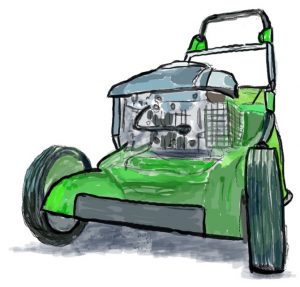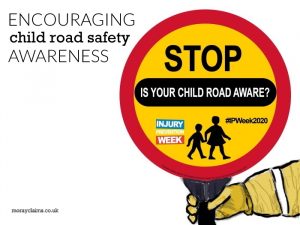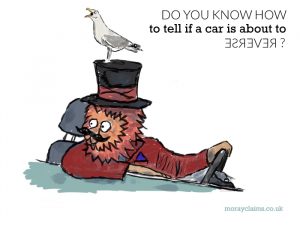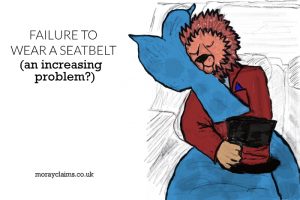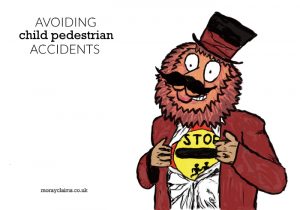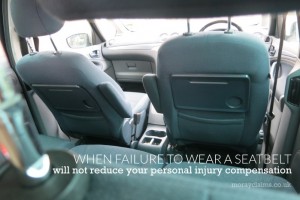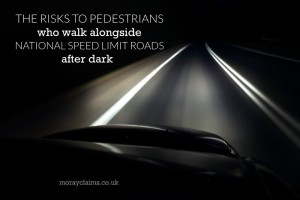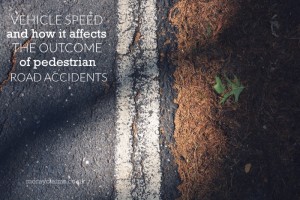Imagine you've been cutting grass with a self-propelled rotary petrol mower - like the ones shown in various images in this article. (You don't 'push' such lawnmowers. They are propelled along by their engines). You stop the engine to adjust the height of the blade. While you're doing that, completely without warning and unexpectedly, the motor restarts of its own accord. The blade spins into action and you suffer serious injury to your hand as a result. Statistics from the USA show that there was an average of about 85,000 lawnmower-related injuries annually in the period 2005 to 2015. The most commonly injured body parts were the hand/finger (22%) followed by the lower extremities (i.e. toes) (16%). Men were more than 3 times as likely to be injured as women. The annual number of lawnmower-related injuries showed no decrease during the period 2005 to 2015. The purpose of this article is to highlight a particular risk associated with petrol-driven Continue Reading
Encouraging child road safety awareness
Nearly two-thirds of parents do not think their children have a good understanding of the dangers or concentrate properly near roads That’s one of the findings of a YouGov survey commissioned by the Association of Personal Injuries for Injury Prevention Week 2020. In the UK-wide study, parents of school-age children were asked to think about how confident they are about their child or children’s road safety awareness. The child road safety survey results are as follows. The remainder said their children have a very good understanding of the dangers – which is great - but we want to address the near 2/3rds of parents who are not so confident. Your biggest helper comes in the form of the Green Cross Code. Arguably, it’s as important for children to learn as spelling and multiplication. The Highway Code says that children should be taught the Green Cross Code and should not be allowed out alone until they can understand and use it properly. This is Continue Reading
Pocket that phone and help prevent needless injuries on the roads
It does not look the sort of road you would expect to see a pedestrian try to cross. Other than at traffic lights. Or using a bridge or underpass. Viewed through the dashcam of the slow-moving car in queuing traffic, we can see it’s an urban environment. The road has 4 lanes in each direction (we’re in the 3rd lane). A continuous concrete barrier about 4 feet high forms the central reservation. A young woman steps off the pavement to our left and begins crossing from left to right – for her, crossing the first half of the road. She’s on her mobile. She’s holding it up to her right ear. We can see her left hand gesturing as she chats. The field of view is distorted by the wide angle lens of the dashcam – it makes things look further away than they are in fact. As the woman crosses in front of our vehicle, she bows slightly to thank us for making room for her to pass through. The outside lane to our right has been empty throughout the 8 seconds or so since she Continue Reading
Do you know how to tell if a car is about to reverse?
Once we know something, we find it difficult to imagine what it was like not to know it. This is known as the Curse of Knowledge. Here’s an example. In a 1990 experiment, pairs of people had to try to identify 120 well-known songs – e.g. Happy Birthday to You. One of them was to tap out the rhythm on a table and the other had to guess the song from that rhythm alone. On average, the listeners guessed only 3 out of 120 songs – a success rate of just 2.5%. Startlingly, though, when the tappers were asked to predict how many of the songs the listeners would guess, they reckoned the odds were 50/50 (50%). The tappers got their tune identified 1 time in 40, but they thought it would be 1 time in 2. Of course, the tappers were hearing the tune in their heads as they tapped. They couldn’t imagine what it was like for the listeners to hear isolated taps – more akin to Morse Code – rather than a song. The tappers’ knowledge had “cursed” them. In road safety terms, it Continue Reading
Failing to wear a seatbelt (A problem on the increase?)
The all-time best-selling album of piano music is The Köln Concert by Keith Jarrett. It was recorded at Cologne’s Opera House on 24 January 1975 before an audience of about 1400 people. It’s the best-selling solo album in jazz history (with sales of more than 3.5 million). An astonishing display of improvisational melody and musicianship. Yet it almost did not happen. The piano provided for the late-night performance was sub-standard. Its bass notes were muffled and its high notes tinny. Jarrett himself was suffering from flu. He almost drove off into the night, leaving the first-time, teenage concert promoter, Vera Brandes, to “face the music” of a disappointed and possibly irate public. But he didn’t. Taking pity on Vera – “doing it just for her” – he took a chance and produced one of jazz’s most iconic performances. Risk-taking does not always have good consequences, of course. Failing to wear a seatbelt does not cause a collision but, if a collision occurs, Continue Reading
Avoiding Child Pedestrian Accidents
School crossing patrols stopped in Moray from 20 August 2019. Meaning no more lollipop people to guide our children across the roads. We have to hope that the publicity this controversial Council cutback has received will mean all drivers will take extra special care when in the vicinity of any Moray school. In this article, we will consider 3 matters in relation to pedestrian road traffic accidents involving children. Firstly, we will consider the evidence about road safety measures such as school crossing patrols and why they provide useful benefits. We will then go on to look at the relative duties of drivers and child pedestrians and what scope there is for some of the blame falling on the injured child (contributory negligence). Finally, by means of an example, we will examine the issues that can arise along with contributory negligence, including possible shifting of blame onto a parent who has not taken proper care for their child's safety (in letting them out alone Continue Reading
5 tradesman-related issues to consider if you are getting work done on your house
At Grigor & Young (Moray Claims is a trading name of Grigor & Young) we get a lot of enquiries from people who need legal advice in relation to work done on their house, usually somewhere in Moray. This covers everything from new builds to renovations and extensions. The types of contractors involved include builders, electricians, plumbers, joiners and double-glazing companies. In varying degrees, these situations are a "nightmare" and, as we go on to explain below, it is often not financially realistic to engage the services of a solicitor to help you. Essentially, this article is an effort to warn you of the need to plan and organise various things at the beginning rather than leaving them until later - when things have already gone wrong and it's "too late". Unlike many articles on this website, while we still hope to educate and inform you, we're not hoping to get business from it... If you’re going to get work done on your property, here are 5 things to Continue Reading
If you were not wearing a cycle helmet can you still claim for personal injury?
The law in the UK does not require pedal cyclists to wear a helmet. What this means is that you won’t be stopped by the police if you fail to wear a cycle helmet. You won’t be prosecuted under the criminal law. On the other hand, Rule 59 of the Highway Code categorises cyclists as vulnerable road users and advises that cyclists ‘should wear a cycle helmet which conforms to current regulations, is the correct size and securely fastened’. The Highway Code is relevant to both criminal and civil law. Claims for personal injury compensation are civil claims for damages, so the Highway Code is relevant. Many cyclists ride without a helmet. Only just over a third of cyclists using major urban roads wore cycle helmets, according to research findings of the UK’s Transport Research Laboratory in 2008. Equivalent research in Germany apparently showed that only 11 % of cyclists in towns and cities wear a cycle helmet. Cycle helmets have to comply with a European standard. This Continue Reading
When not wearing a seatbelt will not reduce your personal injury compensation at all
The modern car seatbelt was invented by a former aviation engineer, whose experience included working on ejector seats. By 1959, cars had seatbelts but only two-point waist restraints. In a car accident, this often did the wearer as much harm as good. Volvo engineer, Nils Bohlin, created a design which anchored the straps low beside the seat. This meant that the geometry of the belts formed a “V” - pointing at the floor – and that the belt would remain in place and not shift under sudden loading. Such a significant advance in driver and passenger safety could have netted Volvo a fortune on the patent. Instead, they gave it away. They decided that the invention was so revolutionary that its value should not profit their company but be a free, life-saving tool. In the world of personal injury claims, if you fail to wear a seat belt and are injured in a road traffic accident, you don’t expect to be free from blame. As we’ve examined elsewhere on this website, UK personal injury Continue Reading
Why Walking on National Speed Limit Roads during the Hours of Darkness is such a Bad Idea
Most of us did this experiment in school Science class. Using a 30cm ruler, one person holds it at the “30” mark and lets it hang down vertically. Their partner (person 2) puts the thumb and first finger of one hand at either side of the “0cm” mark on the ruler. Person 2’s fingers should almost touch the ruler, but not quite. Without warning, person 1 lets go of the ruler. Person 2 tries to stop the ruler’s descent as quickly as they can, by closing their finger and thumb together. You record the level (in cm), just above person 2’s finger, where the ruler was caught. You repeat the test five times and work out the average “catch distance” for the person. A conversion table allows you to translate the distance along the ruler into a reaction time, in milliseconds (thousandths of a second – i.e. one second is a thousand milliseconds). According to one such table, the first centimetre (“0cm – 1cm”) equates to 50 milliseconds. It then increases by 10 milliseconds per Continue Reading
How Speed Affects the Outcome of Pedestrian Road Accident Collisions
Escape velocity is the speed an object must reach to break the bonds of a planet’s gravitational force and get into orbit. To enter orbit around the Earth, for example, a spacecraft needs to be going at a staggering 7 miles per second (25,000 miles per hour). This creates a difficult series of connected problems. The vehicle requires a lot of fuel. Fuel adds weight. More weight means more thrust is required. Greater thrust demands more fuel. And so it goes on … Another situation where speed has a crucial effect on the outcome is in relation to pedestrian road traffic accidents. In this article, we will consider the significance of vehicle speed in pedestrian collisions. Secondly, we will consider the effect of some other factors apart from impact speed. Finally, we will look at some of the implications for measures which can be taken to improve road safety. Frontal impact collision research has considered the effect of speed. Research into road accidents involving Continue Reading
Test Your Knowledge of Ladder and Stepladder Safety
In the period 2004/05, according to HSE statistics, a third of all reported incidents involving a fall from height also involved ladders or stepladders. This equated to an average of 14 deaths from ladder accidents per year and 1,200 major injuries in the workplace. Many injuries were caused by incorrect use of the equipment. HSE’s theory was that misuse of ladders at work could be partly explained by the way they were used in the home. They did not elaborate on that observation but they probably meant that we all tend to learn about the use of ladders and stepladders by trial and error and from other people (e.g. relatives) who are not necessarily trained in their use. This results in us having an unjustified level of confidence in the use of ladders and stepladders. It can lead to dangers in the home but it is likely to be much more dangerous in the workplace. HSE’s figures for 2014/15 show that falls from height accounted for nearly three in ten fatal injuries to workers (41 Continue Reading
